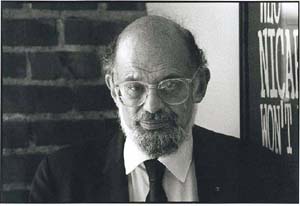Allen Ginsberg
|
|
Irwin Allen Ginsberg (June 3, 1926 – April 5 1997) was an American Beat poet born in Paterson, New Jersey. He formed a bridge between the Beat movement of the 1950s and the hippies of the 1960s, befriending, among others, Jack Kerouac, Neal Cassady, William S. Burroughs, Timothy Leary, Gregory Corso, Herbert Huncke, Rod McKuen, and Bob Dylan.
Ginsberg's poetry was strongly influenced by modernism, romanticism, the beat and cadence of jazz, and his Kagyu Buddhist practice and Jewish background. He considered himself to have inherited the visionary and homoerotic poetic mantle handed from the English poet and artist William Blake on to Walt Whitman. The power of Ginsberg's verse, its searching, probing focus, its long and lilting lines, as well as its New World exuberance, all echo the continuity of inspiration which he claimed. Other influences included the American poet William Carlos Williams.
Ginsberg's principal work, "Howl", is well-known to many for its opening line: "I saw the best minds of my generation destroyed by madness". It was considered scandalous at the time of publication due to the rawness of the language, which is frequently explicit. Shortly after its 1956 publication by San Francisco's City Lights Bookstore, it was banned for obscenity. The ban became a cause célèbre among defenders of the First Amendment, and was later lifted after judge Clayton W. Horn, declared the poem to possess redeeming social importance. Ginsberg's liberal and generally anti-establishment politics attracted the attention of the FBI, who regarded Ginsberg as a major security threat.
It is of some interest to note that the second part of Howl was inspired and written primarily during a peyote vision. Ginsberg attempted a number of poems while under the influence of various drugs, including LSD. This practice was a specific manifestation of his more general experimental approach. He also "wrote" poems by reciting them into tape recorders and transcribing the results, and -- after being encouraged by Chögyam Trungpa (see below) -- he began extemporaneous composition on stage.
In his writing and in his life Ginsberg strove for freedom and authenticity. Many of his poems are extremely honest and direct. For example, in "Kaddish" he describes his mother's madness in unflinching terms. In "Many Loves" he describes his first sexual contact with Neal Cassady, a lover and friend. Some of his later poems focus on his relationship with Peter Orlovsky, his lifetime lover to whom he dedicated Kaddish and Other Poems.
Allen_Ginsberg_am_Frankfurter_Flughafen.jpg
His spiritual journey began early on with spontaneous visions, and continued with an early trip to India and a chance encounter on a New York City street (they both tried to catch the same cab) with Chögyam Trungpa, Rinpoche, a Tibetan Buddhist meditation master of the Vajrayana school, who became his friend and life-long teacher.
In his political life he was an iconoclast, using his wit and humor to militate for the cause of others' personal freedom, often at significant risk to himself. Ginsberg also helped found the Jack Kerouac School of Disembodied Poetics at Naropa University in Boulder, Colorado, a school founded by Chögyam Trungpa, Rinpoche.
In 1993, the French Minister of Culture awarded him with the medal of Chevalier des Arts et des Lettres.
| Contents |
List of works
- Howl and Other Poems (1956)
- Kaddish and Other Poems (1961)
- Reality Sandwiches (1963)
- The Yage Letters (1963) - with William S. Burroughs
- Planet News (1968)
- The Gates of Wrath: Rhymed Poems 1948-1951 (1972)
- The Fall of America: Poems of These States (1973)
- Iron Horse (1974)
- Mind Breaths (1978)
- Plutonian Ode: Poems 1977-1980 (1982)
- Collected Poems: 1947-1980 (1984)
- White Shroud Poems: 1980-1985 (1986)
- Cosmopolitan Greetings Poems: 1986-1993 (1994)
- Howl Annotated (1995)
- Iluminated Poems (1996)
- Selected Poems: 1947-1995 (1996)
- Death and Fame: Poems 1993-1997 (1999)
Quotes
- "Our goal was to save the planet and alter human consciousness. That will take a long time, if it happens at all."
External links
- Allen Ginsberg (http://www.heureka.clara.net/art/ginsberg.htm)
- "Ginsberg's Celestial Homework" (http://www.levity.com/digaland/celestial) Specialized Reading List for "Literary History of the Beat Generation," a course taught by Allen Ginsberg at Naropa Institute during the summer of 1977.
- "The clearing house for all things Ginsberg" (http://www.ginzy.com/)
- On Allen Ginsberg (http://www.lichtensteiger.de/ginsberg.html) by Ralph Lichtensteiger
- "The Great Marijuana Hoax -- Allen Ginsberg" (http://www.theatlantic.com/issues/66nov/hoax.htm)(the first half of which was written on marijuana)
- NAMBLA Ginsberg Page (http://216.220.97.17/ginsberg.htm)
- allenginsberg.org | MP3 files and much more (http://www.allenginsberg.org/home.asp)
- Naropa Audio Archives: Allen Ginsberg class (August 6th, 1976) (http://www.archive.org/audio/audio-details-db.php?collection=naropa&collectionid=naropa_allen_ginsberg&from=BA) Streaming audio and 64 kbit/s MP3 ZIP!
- Naropa Audio Archives: Anne Waldman and Allen Ginsberg reading, including Howl (August 9th, 1975) (http://www.archive.org/audio/audio-details-db.php?collection=naropa&collectionid=naropa_anne_waldman_and_allen_ginsberg&from=mostViewed) Streaming audio and 64 kbit/s MP3 ZIP!
Further Reading
- Miles, Barry. Ginsberg: A Biography. London: Virgin Publishing Ltd. (2001), paperback, 628 pages, ISBN 0753504863
- Schumacher, Michael (edt.). Family Business: Selected Letters Between a Father and Son. Bloomsbury (2002), paperback, 448 pages, ISBN 1582342164bg:Алън Гинсбърг
de:Allen Ginsberg fr:Allen Ginsberg it:Allen Ginsberg he:אלן גינסברג nl:Allen Ginsberg pl:Allen Ginsberg fi:Allen Ginsberg sv:Allen Ginsberg

